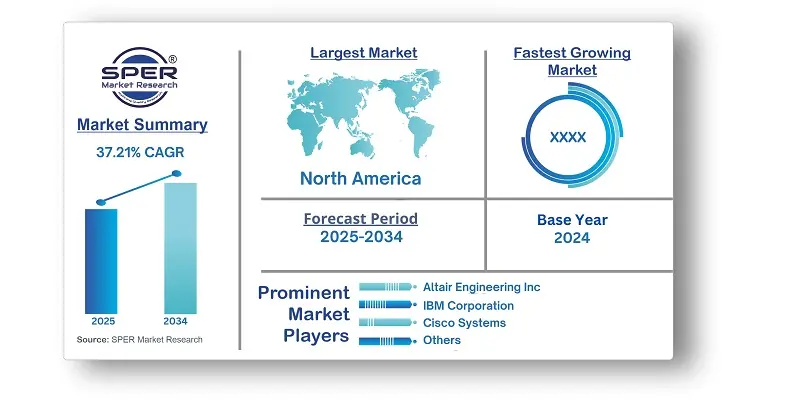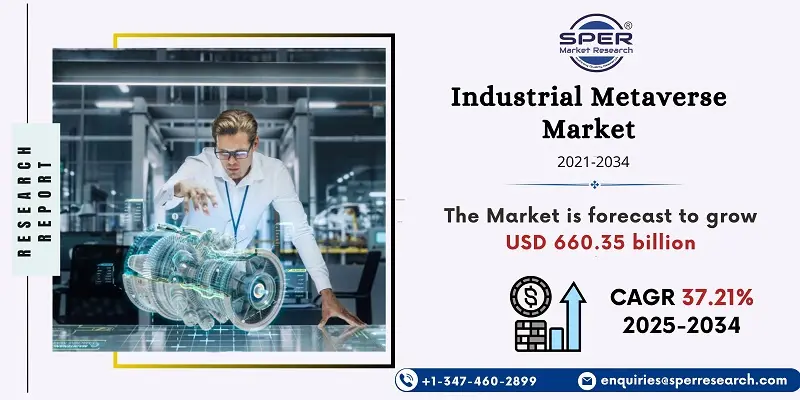Industrial Metaverse Market Introduction and Overview
According to SPER Market Research, the Global Industrial Metaverse Market is estimated to reach USD 660.35 billion by 2034 with a CAGR of 37.21%.
The report includes an in-depth analysis of the Global Industrial Metaverse Market, including market size and trends, product mix, Applications, and supplier analysis. The global industrial metaverse market was valued at USD 27.92 billion in 2024 and is expected to grow at a 37.21% CAGR from 2025 to 2034. The incorporation of digital twins has considerably enhanced the industrial metaverse industry by providing virtual representations of physical assets and processes, hence driving efficiency and innovation. Digital twins enable real-time monitoring, predictive analytics, and simulation capabilities, allowing industrial metaverses to optimise processes, increase efficiency, and reduce hazards. This technology encourages seamless cooperation and decision-making across several industrial sectors, accelerating the emergence of interconnected virtual environments.

By Technology Insights: The industrial metaverse market is divided into several technology segments, including AR/VR, digital twin, autonomous robots, cloud computing, AI/ML, 5G/6G, blockchain, IoT, location services, edge computing, exoskeleton, and quantum computing. By 2025, cloud computing is predicted to hold the largest market share. This dominance is due to its ability to deliver IT resources on-demand via the Internet with pay-as-you-go pricing, improve operational efficiency in hosting the industrial metaverse, and minimize outages while protecting personal information.
By Application Insights:
By Application: The Prototyping, Testing, and Simulation Segment to Dominate the Industrial Metaverse Market in 2024 The industrial metaverse market is divided into several applications, including prototyping, testing, and simulation, predictive maintenance, training, facility optimization, research & development, workplace safety, warehousing & logistics, customer interactions, and more. In 2024, the prototyping, testing, and simulation segment is predicted to hold the largest market share due to benefits like faster product development, fewer costly mistakes, a flexible approach to product development, and real-time collaboration among teams in different locations.

By End-use Industry Insights: The industrial metaverse market is divided by end-use industry into automotive, industrial goods & manufacturing, power & utilities, transportation, supply chain & logistics, and others. In 2024, the industrial goods & manufacturing segment is projected to hold the largest share. This is due to complex product development, dependence on simulation and testing, and ongoing innovation needs.
Regional Insights: North America dominated the industrial metaverse market in 2024, holding the largest revenue share. The region has a strong industrial base in sectors like manufacturing, automotive, aerospace, and healthcare, which are early adopters of these technologies to boost productivity, efficiency, and innovation. Additionally, North America's digital connectivity infrastructure supports the integration and deployment of industrial metaverse solutions for collaboration and data sharing.
Market Competitive Landscape:
The market has strong competition, with a few major global competitors holding a large share. The main priority is to develop new products and collaborate among key players. HTC is a leading technology company known for its innovative products and strong user experience. They are influencing the industrial metaverse by providing advanced virtual reality and augmented reality solutions for different industries. HTC's goal is to create immersive experiences that improve collaboration, training, and productivity in the industrial sector. Their focus on the metaverse helps drive digital transformation and creates new growth opportunities.
Recent Developments:
- In March 2024, NVIDIA partnered with Microsoft Corporation to provide NVIDIA Omniverse Cloud, a service that helps companies integrate digitalization, connect 3D design tools, create digital twins of factories, and test vehicle performance.
- In June 2024, Siemens, NVIDIA, and AWS partnered to enhance the industrial metaverse. They will use Siemens expertise, NVIDIAs Omniverse platform, and AWSs cloud services to create real-time, collaborative digital twin solutions for improved design and operations.
- In January 2024, Siemens AG announced key partnerships and AI advancements to enhance the industrial metaverse. They introduced a new immersive engineering solution with Sony, combining Sonys head-mounted displays with the Siemens Xcelerator platform. This initiative seeks to support global innovators and change industrial design and manufacturing.
Scope of the Report:
| Report Metric | Details |
| Market size available for years | 2021-2034 |
| Base year considered | 2024 |
| Forecast period | 2025-2034 |
| Segments covered | By Technology, By Application, By End-use Industry. |
| Regions covered | North America, Latin America, Asia-Pacific, Europe, and Middle East & Africa. |
| Companies Covered | ABB Ltd, Siemens AG, IBM Corporation, Robert Bosch GmbH, Oracle Corporation, Microsoft Corporation, Nvidia Corporation, Cisco Systems, Inc, Dassault Systemes SE, Altair Engineering Inc, PTC Inc, Intel Corporation, Penguin Solutions, SAP SE, Arm Limited. and others. |
Key Topics Covered in the Report:
- Global Industrial Metaverse Market Size (FY’2021-FY’2034)
- Overview of Global Industrial Metaverse Market
- Segmentation of Global Industrial Metaverse Market By Technology (AR/VR, Digital Twin, Autonomous Robots, Cloud Computing, AI/ML, 5G/6G, Blockchain, IoT, Location Services, Edge Computing, Exoskeleton)
- Segmentation of Global Industrial Metaverse Market By Application (Prototyping, Testing, and Simulation, Predictive Maintenance, Training, Facility Optimization, Research & Development, Workplace Safety, Warehousing & Logistics, Customer Interactions, Other Applications)
- Segmentation of Global Industrial Metaverse Market By End-use Industry (Automotive, Industrial Goods & Manufacturing, Power & Utilities, Transportation, Supply Chain & Logistics, Other End-use Industries)
- Statistical Snap of Global Industrial Metaverse Market
- Expansion Analysis of Global Industrial Metaverse Market
- Problems and Obstacles in Global Industrial Metaverse Market
- Competitive Landscape in the Global Industrial Metaverse Market
- Details on Current Investment in Global Industrial Metaverse Market
- Competitive Analysis of Global Industrial Metaverse Market
- Prominent Players in the Global Industrial Metaverse Market
- SWOT Analysis of Global Industrial Metaverse Market
- Global Industrial Metaverse Market Future Outlook and Projections (FY’2025-FY’2034)
- Recommendations from Analyst
1. Introduction
1.1. Scope of the report
1.2. Market segment analysis
2. Research Methodology
2.1. Research data source
2.1.1. Secondary Data
2.1.2. Primary Data
2.1.3. SPERs internal database
2.1.4. Premium insight from KOLs
2.2. Market size estimation
2.2.1. Top-down and Bottom-up approach
2.3. Data triangulation
3. Executive Summary
4. Market Dynamics
4.1. Driver, Restraint, Opportunity and Challenges analysis
4.1.1. Drivers
4.1.2. Restraints
4.1.3. Opportunities
4.1.4. Challenges
5. Market variable and outlook
5.1. SWOT Analysis
5.1.1. Strengths
5.1.2. Weaknesses
5.1.3. Opportunities
5.1.4. Threats
5.2. PESTEL Analysis
5.2.1. Political Landscape
5.2.2. Economic Landscape
5.2.3. Social Landscape
5.2.4. Technological Landscape
5.2.5. Environmental Landscape
5.2.6. Legal Landscape
5.3. PORTERs Five Forces
5.3.1. Bargaining power of suppliers
5.3.2. Bargaining power of buyers
5.3.3. Threat of Substitute
5.3.4. Threat of new entrant
5.3.5. Competitive rivalry
5.4. Heat Map Analysis
6. Competitive Landscape
6.1. Global Industrial Metaverse Market Manufacturing Base Distribution, Sales Area, Product Type
6.2. Mergers & Acquisitions, Partnerships, Product Launch, and Collaboration in Global Industrial Metaverse Market
7. Global Industrial Metaverse Market, By Technology (USD Million) 2021-2034
7.1. AR/VR
7.2. Digital Twin
7.3. Autonomous Robots
7.4. Cloud Computing
7.5. AI/ML
7.6. 5G/6G
7.7. Blockchain
7.8. IoT
7.9. Location Services
7.10. Edge Computing
7.11. Exoskeleton
8. Global Industrial Metaverse Market, By Application (USD Million) 2021-2034
8.1. Prototyping, Testing, and Simulation
8.2. Predictive Maintenance
8.3. Training
8.4. Facility Optimization
8.5. Research & Development
8.6. Workplace Safety
8.7. Warehousing & Logistics
8.8. Customer Interactions
8.9. Other Applications
9. Global Industrial Metaverse Market, By End-use Industry (USD Million) 2021-2034
9.1. Automotive
9.2. Industrial Goods & Manufacturing
9.3. Power & Utilities
9.4. Transportation
9.5. Supply Chain & Logistics
9.6. Other End-use Industries
10. Global Industrial Metaverse Market, (USD Million) 2021-2034
10.1. Global Industrial Metaverse Market Size and Market Share
11. Global Industrial Metaverse Market, By Region, (USD Million) 2021-2034
11.1. Asia-Pacific
11.1.1. Australia
11.1.2. China
11.1.3. India
11.1.4. Japan
11.1.5. South Korea
11.1.6. Rest of Asia-Pacific
11.2. Europe
11.2.1. France
11.2.2. Germany
11.2.3. Italy
11.2.4. Spain
11.2.5. United Kingdom
11.2.6. Rest of Europe
11.3. Middle East and Africa
11.3.1. Kingdom of Saudi Arabia
11.3.2. United Arab Emirates
11.3.3. Qatar
11.3.4. South Africa
11.3.5. Egypt
11.3.6. Morocco
11.3.7. Nigeria
11.3.8. Rest of Middle-East and Africa
11.4. North America
11.4.1. Canada
11.4.2. Mexico
11.4.3. United States
11.5. Latin America
11.5.1. Argentina
11.5.2. Brazil
11.5.3. Rest of Latin America
12. Company Profile
12.1. ABB Ltd
12.1.1. Company details
12.1.2. Financial outlook
12.1.3. Product summary
12.1.4. Recent developments
12.2. Siemens AG
12.2.1. Company details
12.2.2. Financial outlook
12.2.3. Product summary
12.2.4. Recent developments
12.3. IBM Corporation
12.3.1. Company details
12.3.2. Financial outlook
12.3.3. Product summary
12.3.4. Recent developments
12.4. Robert Bosch GmbH
12.4.1. Company details
12.4.2. Financial outlook
12.4.3. Product summary
12.4.4. Recent developments
12.5. Oracle Corporation
12.5.1. Company details
12.5.2. Financial outlook
12.5.3. Product summary
12.5.4. Recent developments
12.6. Microsoft Corporation
12.6.1. Company details
12.6.2. Financial outlook
12.6.3. Product summary
12.6.4. Recent developments
12.7. Nvidia Corporation
12.7.1. Company details
12.7.2. Financial outlook
12.7.3. Product summary
12.7.4. Recent developments
12.8. Cisco Systems, Inc
12.8.1. Company details
12.8.2. Financial outlook
12.8.3. Product summary
12.8.4. Recent developments
12.9. Dassault Systèmes SE
12.9.1. Company details
12.9.2. Financial outlook
12.9.3. Product summary
12.9.4. Recent developments
12.10. Altair Engineering Inc
12.10.1. Company details
12.10.2. Financial outlook
12.10.3. Product summary
12.10.4. Recent developments
12.11. PTC Inc
12.11.1. Company details
12.11.2. Financial outlook
12.11.3. Product summary
12.11.4. Recent developments
12.12. Intel Corporation
12.12.1. Company details
12.12.2. Financial outlook
12.12.3. Product summary
12.12.4. Recent developments
12.13. Penguin Solutions
12.13.1. Company details
12.13.2. Financial outlook
12.13.3. Product summary
12.13.4. Recent developments
12.14. SAP SE
12.14.1. Company details
12.14.2. Financial outlook
12.14.3. Product summary
12.14.4. Recent developments
12.15. Others
13. Conclusion
14. List of Abbreviations
15. Reference Links